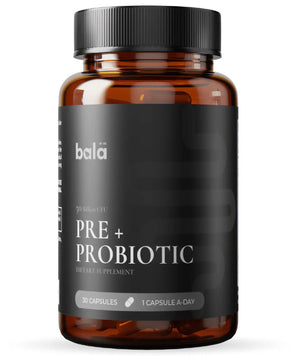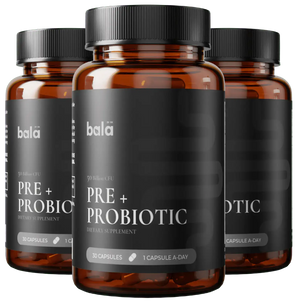Table of Contents
Introduction
Imagine you're prescribed antibiotics for an infection, feeling hopeful that these powerful medications will help you recover. But did you know that while antibiotics fight off harmful bacteria, they also wipe out beneficial bacteria in your gut? This disruption can lead to uncomfortable side effects like bloating, diarrhea, and even long-term digestive issues. In fact, studies show that 5% to 30% of people taking antibiotics experience antibiotic-associated diarrhea (AAD). So, how do we protect our gut health during this time?
At Bala Health, we’re here to simplify your wellness journey. Our mission is to empower you with clean, science-backed probiotics that support your body's natural functions. In this post, we will explore the intricate relationship between antibiotics and probiotics, provide recommendations on how much probiotics to take while on antibiotics, and guide you through the best types of probiotics to consider. Whether you're dealing with digestive issues or simply looking to maintain your gut health, this guide will equip you with the knowledge you need.
Are you tired of the confusion that often accompanies gut health? Struggling to figure out what works? You’re not alone. We aim to clarify the role of probiotics during antibiotic treatment, helping you make informed decisions about your health. By the end of this article, you’ll understand how to best support your gut microbiome while on antibiotics and feel empowered to take charge of your digestive health.
Understanding the Role of Probiotics During Antibiotic Treatment
Antibiotics have transformed modern medicine, effectively treating bacterial infections that were once life-threatening. However, their non-selective action means they can also destroy beneficial bacteria in our gut, leading to an imbalance known as dysbiosis. This imbalance can manifest in various gastrointestinal issues, including AAD.
The Importance of Probiotics
Probiotics are live microorganisms that provide health benefits when consumed in adequate amounts. They help restore the balance of gut bacteria that antibiotics may disrupt. Here’s why taking probiotics during antibiotic treatment is essential:
- Restoring Gut Flora: Probiotics help replenish beneficial bacteria that antibiotics may have eradicated, maintaining digestive health and preventing diarrhea.
- Enhancing Immune Function: A healthy gut microbiome is crucial for a robust immune system. Probiotics can support immune function during antibiotic use.
- Reducing Side Effects: By taking probiotics, individuals may experience fewer side effects associated with antibiotics, allowing for a smoother treatment process.
- Promoting Digestive Health: Probiotics can enhance digestion and nutrient absorption, which is particularly important while recovering from an infection.
Research Insights
A systematic review and meta-analysis of numerous studies indicate that probiotics can significantly reduce the risk of AAD by up to 64%. This protective effect arises from the ability of probiotics to re-colonize the gut with beneficial bacteria, thereby restoring balance and function. So, how much should we take while on antibiotics?
Recommended Dosage of Probiotics While on Antibiotics
Determining the appropriate dosage of probiotics while on antibiotics can be nuanced and depends on various factors, including the type of antibiotic, individual health status, and specific probiotic strains used. Research suggests that individuals taking antibiotics should aim for a daily intake of probiotics ranging from 5 billion to 40 billion colony-forming units (CFUs). Here’s a breakdown of recommended dosages:
- 5 to 10 billion CFUs: This lower range may suffice for individuals with mild digestive disturbances or those seeking to maintain gut health during a short course of antibiotics.
- 10 to 20 billion CFUs: This moderate range is often recommended for individuals experiencing AAD or more significant disruptions to gut health.
- 20 to 40 billion CFUs: This higher range may be beneficial for those on prolonged antibiotic therapy, particularly if they have a history of severe gastrointestinal issues or are at a higher risk for AAD.
It's important to note that the effectiveness of probiotics can also depend on the specific strains used. Research has identified several strains, including Lactobacillus rhamnosus and Saccharomyces boulardii, as particularly effective in preventing AAD.
Timing of Probiotic Intake
For optimal results, it is generally recommended to take probiotics at least two hours apart from antibiotic doses. This timing helps ensure that the probiotics can survive the antibiotic treatment and effectively populate the gut. For instance, if you take your antibiotic at breakfast, consider taking your probiotic with lunch or a mid-morning snack.
Types of Probiotics to Consider
When selecting a probiotic to take alongside antibiotics, it’s essential to choose strains that have been clinically validated for their effectiveness. Here are some of the most researched probiotic strains for use during antibiotic therapy:
- Lactobacillus rhamnosus GG: This strain has been shown to reduce the incidence of AAD and enhance gut health.
- Saccharomyces boulardii: A beneficial yeast that can survive antibiotic treatment and has been effective in preventing AAD.
- Bifidobacterium lactis: This strain supports gut health and helps restore beneficial bacteria following antibiotic use.
- Lactobacillus acidophilus: Known for its digestive health benefits, this strain can help maintain gut balance.
At Bala Health, we offer a range of probiotic formulations designed with high-quality, science-backed ingredients to support your health. Our commitment to transparency means you can trust that our products contain no hidden ingredients, and our advanced delivery methods ensure optimal bioavailability for maximum effectiveness.
Empowering Your Gut Health Journey
By understanding the intricate relationship between antibiotics and probiotics, we can take proactive steps to support our gut health. Incorporating probiotics into your regimen while on antibiotics can help restore balance to your microbiome, enhance immune function, and reduce the risk of digestive disturbances.
Take Our Weight-Loss Quiz
As part of our commitment to empowering our community, we invite you to take our 3-minute Weight-Loss Quiz. This quiz will help you discover personalized recommendations for your gut health journey.
Shop Our Clinically-Backed Probiotic
Are you ready to take the next step? Shop our clinically-backed probiotic now and start your journey to better gut health. With our science-first approach, you can feel confident that you’re making a beneficial choice for your well-being.
Conclusion
In conclusion, understanding how much probiotics to take while on antibiotics can significantly impact your gut health and overall wellness. By aiming for a daily intake of 5 to 40 billion CFUs of clinically validated probiotic strains, you can effectively support your gut health during antibiotic treatment.
At Bala Health, we are dedicated to providing high-quality, science-backed supplements to empower you on your wellness journey. As you consider your next steps, we encourage you to reflect on your own health journey. How have antibiotics affected your digestive health in the past? Are you ready to take proactive measures to support your gut microbiome? Together, let’s continue to explore the best ways to enhance our health and well-being.
Before you go, don’t forget to take our Weight-Loss Quiz to find your personalized gut-health roadmap, and shop our probiotics to feel better from the inside out.
FAQ Section
Can I take probiotics and antibiotics at the same time?
While it's generally recommended to take probiotics at least two hours apart from antibiotics, some strains, like Lactobacillus rhamnosus and Saccharomyces boulardii, can be taken simultaneously for maximum benefit.
How long should I take probiotics after finishing antibiotics?
It’s advisable to continue taking probiotics for at least one month after completing your antibiotic course to help restore the gut microbiome fully.
Are there any side effects of taking probiotics?
Most individuals tolerate probiotics well, but some may experience mild gastrointestinal symptoms such as gas or bloating. If you have underlying health conditions, consult your healthcare provider before starting probiotics.
How do I know which probiotics to take?
Choose probiotics that contain well-researched strains known for their effectiveness during antibiotic therapy. Our Gut Health Collection features products designed to support your gut microbiome effectively.
Where can I find high-quality probiotics?
You can explore Bala Health’s high-quality probiotic formulations in our Gut Health Collection.
By following the guidance in this article, you can better navigate your health while on antibiotics. Remember, your gut health is crucial to your overall well-being, and we're here to support you every step of the way!






